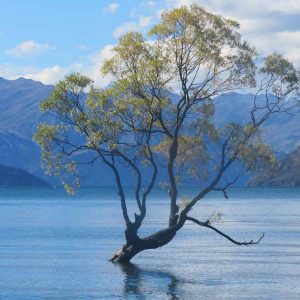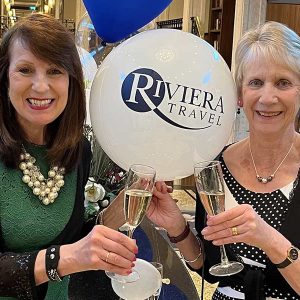We have been holidaying in North Wales for thirty five years and have got to know and love the area well. The main attraction for us was the Ffestiniog Railway. Snowdonia is popular with mountaineers and there is some splendid walking. There are narrow gauge steam railways, the great castles of Edward I and some good beaches for those wanting a traditional beach holiday. Over the years, many attractions have made great efforts to become accessible to all visitors. CADW who is responsible for many of the ruined historic attractions in Wales offers free admission to all its sites for disabled people and their carers. Most properties have websites with details of accessibility. It is worth ringing a property before a visit to check out details and book a wheelchair if needed.
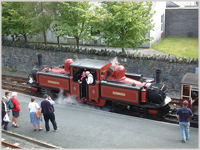 Ffestiniog and Welsh Highland Railways
Ffestiniog and Welsh Highland Railways
These narrow gauge steam railways are two of the ‘Great Little Trains of Wales’. Both run through the glorious scenery of North Wales and are, deservedly, popular tourist attractions. The Ffestiniog Railway was built over 150 years ago to carry slate from the hills above Blaenau Ffestiniog to the harbour at Porthmadog. Some of the locos are well over one hundred years old and can still be seen pulling trains. The iconic double headed Fairlie locos are unique to the Ffestiniog. The experience of being hauled by one of these working flat out with a long train up the valley is exhilarating.
The Welsh Highland Railway has been rebuilt over the last fifteen years on the trackbed of a line that closed in the 1930s. It runs along the flanks of Snowdon between Porthmadog and Caernarfon. Gradients are steep and trains are hauled by Beyer Garrett locos bought from South Africa.
Both railways have wheelchair accessible carriages reached by a portable ramp. Guards are used to helping people with disabilities. The Victorian vintage coaches on the Ffestiniog Railway have narrow doors unsuitable for wheelchairs. Guards have a step to help passengers with mobility problems to get into the coaches. All main stations, platforms shops and toilets are accessible, although some of the smaller halt stations may not be. Disabled passengers travel at concessionary rates.
• Read my reviews about Ffestiniog Railways
• Read my reviews about Welsh Highland Railways
• Visit website
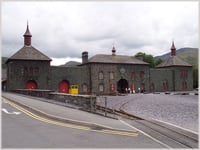 National Slate Museum, Llanberis
National Slate Museum, Llanberis
In the 19thC Wales supplied slates for the roofs of the nation. Hills were riddled with slate caverns and quarries. Evidence of the tramways carrying slate from the mines can still be seen. This museum in the Victorian workshops of the massive Dinorwig quarry which employed over 3000 men, looks at the importance of the slate industry to Wales and the world in its heyday as well as the life of the men who worked the slate. Workmen display the techniques of splitting and dressing slate. There are the barrack blocks where they lived, a row of quarrymen’s cottages, the caban where they met for lunch, the loco shed and their workshops with the mighty waterwheel which provided the power.
There is free disabled parking on display of a blue badge. Wheel chair access to the museum is through the shop where a wheelchair is available on request. Staff are available to help disabled visitors. There is wheelchair access to most parts of the museum along slate paved or shingle paths and a lift to the waterwheel. An easily graded path enables wheelchair users to visit the V2 incline. The pattern loft is only accessible by a steep stairway and access into the quarrymen’s houses is restricted by their very nature. There are large print guide books available and an induction loop and headsets for the 3D show. There is an accessible cafe and shop on the site. Assistance dogs are welcome and admission is free.
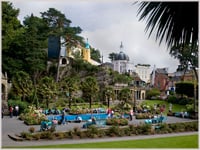 Portmeirion
Portmeirion
Many of us will remember this is where the cult 1960s TV series of the Prisoner was filmed. It’s unusual architecture has led to it being described as the Italianate village. Portmeirion is a joy and delight to visit. Designed by the quirky architect Clough Williams Ellis, it is full of brightly coloured buildings which stand out in bold contrast to the vegetation. Williams Ellis used buildings and trees to frame vistas which change as you walk round the site. It is a photographers delight. There is a hotel, shops and cafes.
There are disabled spaces in the main car park which is a short walk (200m) from the village. There is a disabled space next to the cafe and by the hotel in the village. Most of the footpaths around the village are level, although there are a few steps which can be avoided. The path up from the beach is quite steep. A map shows disabled access. Cafe and shops are all accessible. A land train gives free 20minute rides round the woodlands. When on the train, wheelchairs can be left in the cafe by the stop. There are concessions for the over 60s and half price entry after 15.30. Wheelchair users are free and a carer is admitted at the concessionary rate. It is cheaper to buy tickets on line than at the ticket desk. Assistance dogs are allowed.
• Read a review by another Silver Traveller
• Visit website
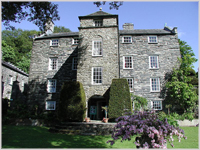 Plas Brondanw Gardens, Llanfrothen, Gwynedd
Plas Brondanw Gardens, Llanfrothen, Gwynedd
Anyone who has enjoyed Portmeirion will like these gardens. The house and gardens were the home of Clough Williams Ellis and he created a typically CWE landscape using the same tricks as in Portmeirion. He relied on stone walls, topiary and avenues of trees to frame vistas leading the eye to the distant mountain tops. They are a delight to walk around.
There is disabled parking by the main gate. The ticket office will arrange for this to be opened to give a wheelchair user level access into the gardens. There is disabled access to the shop and cafe. 70% of the garden is accessible by wheelchair users, who are admitted at half price.
• Read my review
• Visit website
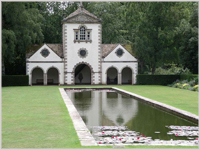 Bodnant Garden
Bodnant Garden
A beautiful garden set on the slopes above the river Conwy, this is a garden for all seasons. In spring the laburnum arch is dripping with yellow flowers. In summer the herbaceous borders are at their best and in autumn there are glorious autumn colours. There are formal gardens with flower beds, grassland with mature trees and along the bottom of the River Hiraethlyn is a wilderness garden.
There is disabled parking about 150m from the entrance. Paths around the gardens vary from gravel to grassy paths. There is a way marked route around the gardens suitable for wheelchair users. Although there is access to the lower parts of the garden, wheelchair users do have to consider the uphill return. The garden has five manual wheelchairs available for visitors and mobility scooters are allowed in the grounds – as long as they have a full battery. Shop, tea room and plant sales are all accessible. There are no concessions for seniors or the disabled, but carers are admitted free.
• Read my review
• Visit website
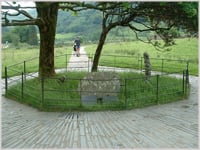 Gelert’s Grave, Beddgelert
Gelert’s Grave, Beddgelert
Beddgelert is a tourist honeypot with visitors attracted by the story of Gelert. The name translates as Gelert’s grave. According to legend, a stone marks the resting place of Gelert, the faithful hound of Llewelyn, Prince of Gwynedd. He had spent the day hunting and returned to find his baby son’s cot empty and Gelert smeared with blood. Thinking that Gelert had killed his son, Llewelyn plunged his sword into the dog’s side. He then discovered his baby son unharmed by the body of a wolf which the faithful Gelert had killed. The prince was filled with remorse and buried the dog with great ceremony. The stone is still there, and it is a lovely walk from the village along a wheelchair friendly path following the banks of the River Glaslyn. The story is now known to be just that, made up by an 18thC landlord of the Goat Hotel to encourage tourism. The village probably took its name from an early Celtic saint named Celert.
• Read my review
• Visit website
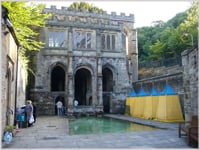 St Winefride’s Well, Holywell
St Winefride’s Well, Holywell
Around 660AD, Saint Winifred spurned the advances of Caradoc, son of a local prince as she wanted to become a nun. He cut off her head in his anger. A spring rose from the ground at the spot where her head fell. Winefride was restored to life by her uncle, St. Bueno, who called down the wrath of God on Caradoc who was struck dead and swallowed up. A spring marks the place she was killed. Miraculous cures were soon attached to the spring and the holy well has been the site of continuous pilgrimage over 1300 years. The well is enclosed in a splendid perpendicular building which is unique in Britain. A popular tourist stop, it is still visited by pilgrims who come to bathe in the pool. There is a small visitor centre with a shop and exhibition about St Winefride and the well.
There is plenty of parking across the road, including disabled parking and a small independently run tea room next door. The holy well is accessible to disabled visitors and there is a wheel chair available. Entry is a few pence.
• Read my review
• Visit website
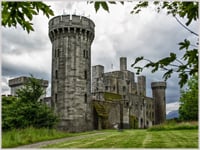 Penrhyn Castle
Penrhyn Castle
This is a splendid neo-Norman castle built above the Menai Strait. The tall square keep dominates the castle with its round windows, arcading and chevrons. Every surface is carved. If the outside is impressive, the inside is even better with a series of stunning rooms. No expense was spared during its construction and the quality of the carving in the grand hall and stairway is mind blowing. The woodwork is equally as good. Rooms are opulently furnished and the slate bed used by Queen Victoria is unique. The house is surrounded by extensive gardens and has a very good railway museum in the stable block. With tea room and shop, this makes a good visit.
There are disabled toilets in the kitchen courtyard. Disabled visitors can park outside the castle. Ask in the Visitor Centre on arrival. The railway museum, shop, tea room are accessible as is much of the grounds. There is ramped access into the castle, but no lift so only the ground floor is accessible. Staff have a photo book of the upstairs rooms. Even so, the caste is well worth a visit as the ground floor rooms are stunning and more impressive than the first floor. There are no concessions for seniors or the disabled, although a carer is admitted free.
• Read my reviews
• Visit website
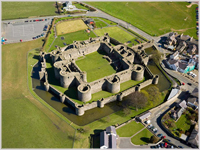 Beaumaris Castle, Anglesey
Beaumaris Castle, Anglesey
This was the last and largest of the Edwardian castles to be built in Wales but was never finished as Edward I ran out of money. It was the most sophisticated example of medieval military architecture. State of the art with moat and two concentric walls lined with towers, it was virtually impregnable. 600 years on it is as impressive as ever.
There is some disabled parking on the road outside the Visitor Centre, otherwise there is a large car park to the west of the castle. There is level access into the visitor centre and a well made path to the bridge across the moat. There is access to both the inner and outer wards which are mown grass. There is no access to the wall walks. There are concessions for seniors and disabled visitors and carers are admitted free. Assistance dogs are allowed.
• Read my review
• Visit website
 Marble Church, Bodelwyddan
Marble Church, Bodelwyddan
Travellers on the A55 will have passed the stunningly beautiful spire of St Margaret’s, the Marble church. The church is built from limestone which gleams in the sunlight. It was built in the 19thC by Lady Margaret Willoughby de Broke in memory of her husband. At a cost of £60,000 pounds, no expense was spared. The inside is Victorian workmanship at its best with marble pillars, elaborate carvings and a splendid chancel. Don’t miss the delightful font at the back with the two nieces of Lady Margaret holding a shell. In the churchyard are the graves of Canadian servicemen from the First World War. There is a small bookstall and a greeter inside the church. There is on road parking outside the church and good disabled access.
• Read my review
• Visit website
• Read more about Accessible Attractions in Great Britain



